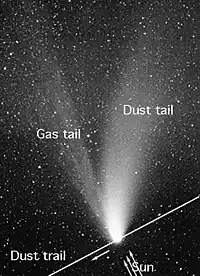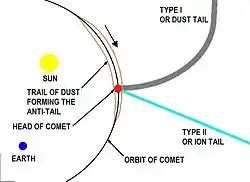彗翎
彗翎(也稱逆向彗尾或反尾)是從彗星的彗髮投射出來的明顯的尖峰,它似乎朝向太陽,因此在幾何上與另一個彗尾相反:離子尾和塵埃尾。然而,這種現象是從地球上看到的視錯覺。彗翎是由更大的塵埃顆粒組成,它們受太陽輻射壓力的影響較小,並傾向於大致保持在彗星的軌道平面內,最終由於顆粒從彗星表面噴出的速度而沿彗星軌道形成盤狀。當地球穿過彗星的軌道平面時,是由側面看見這一盤面,並表現為特徵性的尖峰[1]。儘管盤的另一面往往會消失在塵埃的尾部,但有時仍可以看到。因此,通常只有當地球穿過彗星的軌道平面時,才能在短時間內看到彗翎[2][3]。

彗星塵埃尾的圖,塵埃尾(或彗翎都是以氣體為主的彗尾。NASA

鹿林彗星。左邊的是彗翎,俗稱為反尾;離子尾在右邊。但有評論指出,因為上圖沒有顯示反尾,對下圖則存疑。

顯示從地球上看,彗星可能呈現出與離子尾或塵埃尾方向相反的短尾,即彗翎(反尾)。
大多數彗星都沒有發育到足以看到彗翎的程度,但值得注意的是,確實顯示出彗翎的彗星包括1957年的阿蘭德-羅蘭彗星、1973年的柯侯德彗星[4]、1997年的海爾·波普彗星、和2013年的泛星彗星。
註解
- .
- Rao, Joe. . SPACE.com. 6 February 2009 [2009-02-25]. (原始内容存档于26 February 2009).
- Tosar, Borja; Paolo Candy. . 3.bp.blogspot. [2009-02-25]. (原始内容存档于25 February 2009).
- Naugles, John E. . Committee on Science and Astronautics U.S. House of Representatives. Hearings Before the Subcommittee on Space Science and Applications (Washington DC). 7 March 1974, 25 (3): 401 [2021-11-10].
[drawing on page 403] the Skylab crewmen observed a brilliant spike or anti tail projecting toward the Sun from the head of Kohoutek [...] Dr Zdenek Sekanina concluded that the spike was not wholly due to a perspective or geometrical effect as has been assumed in previous comet studies.
- 有著突出彗翎的阿蘭德·羅蘭彗星影像。 (页面存档备份,存于)
外部連結
- Emily Lakdawalla. . 2009-02-23 [2023-01-27]. (原始内容存档于2014-04-22).
- Online Encyclopedia of Science - Antitail (页面存档备份,存于)
This article is issued from Wikipedia. The text is licensed under Creative Commons - Attribution - Sharealike. Additional terms may apply for the media files.